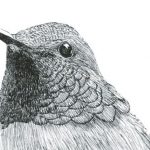As the vernal equinox passes this month, the spring waves of wildflower blooms increase in breadth and vigor. Like the waves crashing on the beach, they are in constant motion yet precisely defined at any instant. Unlike the waves of the ocean, waves of blooming are so slow the human eye cannot detect any motion. Every flower has a slow but steady dance that one must visualize mentally to appreciate its blossoming. This is what makes time-lapse movies of flowers opening so appealing; they give the impression of inexorable actions being speeded up, constantly moving. Continue reading →

